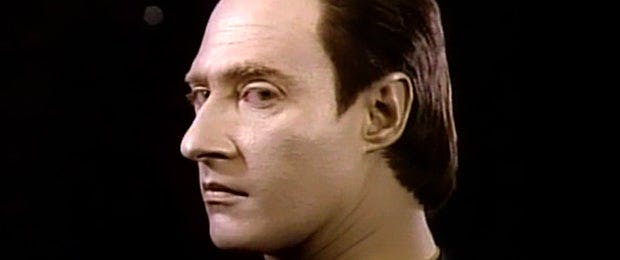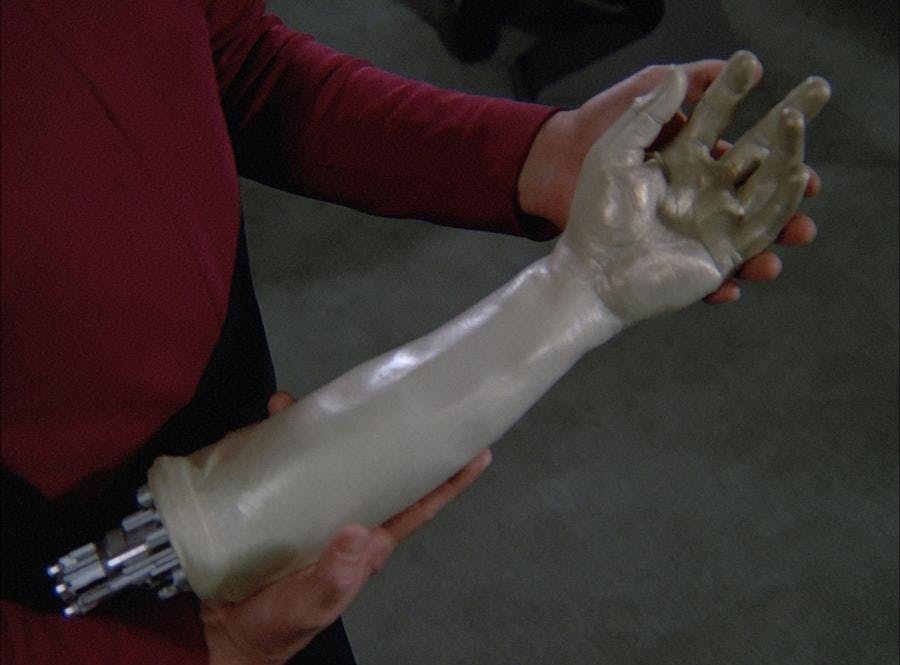Published Nov 28, 2012
Snodgrass Measures "Measure of a Man" On Blu-ray
Snodgrass Measures "Measure of a Man" On Blu-ray

It all started with a Facebook message from Michael Okuda, who casually asked if I still had that old VHS tape of the first cut of THE MEASURE OF A MAN. The cut that was some 13 minutes too long for an episode of Star Trek: The Next Generation.Well, actually, that isn’t where it started. It all started with a little girl who loved science fiction, and grew up watching original Trek, and loving it. A little girl who finally got to see moving pictures of the things she had read in books and only imagined, and then somehow came to work for Star Trek. I confess I wrote MEASURE conceiving of it as an original Trek story. I think it’s true antecedents are THE CITY ON THE EDGE OF FOREVER, JOURNEY TO BABEL, CHARLIE X, BALANCE OF TERROR.But back to the tape. The only copy of the first cut. I walked into the storeroom, picked it up and sent it to Mike and the team preparing the new Blu-ray release of the second season of TNG. It was apparently a struggle to restore because the tape was old and had been stores in less than optimal conditions, but at last it was done.Meanwhile, Robert Meyer Burnett was preparing a series of interviews for the Blu-ray release, and I had gone out to L.A. to talk about Star Trek in general, how I got hired, my thoughts and memories about the show, etc. It was fun and Rob proved to be an excellent interviewer. I returned home and thought I was done.But then Mike and Rob contacted me about doing commentary for the expanded episode. For those of you interested, MEASURE is going to take up a lot of space because the discs will contain not only the expanded version, but the “as-aired” version as well. Then people can watch and really decide if the extra scenes help or hurt the final product.I hadn’t seen the episode in any form in many years, but they sent me a DVD that had the recreated first cut minus music and sound effects. I watched it and began to remember why I had written those extra character moments, and I began to think, “Hey, this works with the added content.”I made a plane reservation and returned to Los Angeles to do the commentary. I confess: I was terrified. I’d never done anything like this, and didn’t want to sound like an idiot. My friend George R.R. Martin (who was directly responsible for me writing a script and getting a job in Hollywood) said there was nothing to it, and we could always go back and fix things if I sounded stupid.Fortunately, I was guided through my first commentary by Mike Okuda and his lovely wife, Denise. It didn’t hurt that they are huge fans of the episode. I arrived at the recording studio, was presented with snacks, coffee and juice and then we went into this tiny room with a screen, and it was time to start.Michael explained that the biggest problem was filling the time. He said the first 15 minutes were easy, and after that it got much harder. Often, the final 15 devolved into discussions of where to have lunch. Maybe it’s because I’m also a novelist in addition to being a screenwriter, but I had no trouble filling the nearly 60 minutes. It also helped that Mike and Denise had prepared insightful questions that helped keep me focused.I realized that many of the scenes that got cut were all small personal moments. A scene between Geordi and Data, in particular. There was also a cut made of a rather tense scene between Picard and Riker. I always thought that Riker was too passive toward Picard, and that there should have been real rivalry. So I put that in a scene. When you see the scene you’ll probably all know that the swordplay should have been done... differently. Anyway, I presented the idea that while Riker didn’t want to harm his friend Data he also wanted to best Picard. I liked the scene and I’m glad it’s back.I think Picard’s closing argument works very well. Of course it helps when you have a Shakespearian actor delivering the summation to a court case.

The upgraded effects are beautiful, but really none of that matters in this episode. It was a completely character-driven story. A chance to present the human heart in conflict with itself, and to discuss essential questions about the nature of humanity.A final note: Today, the extended version of MEASURE, along with Q WHO, will be shown in movie theaters across the United States. It’s a great honor, and I’m very grateful for this opportunity.__________Melinda Snodgrass was born in Los Angeles, but her family moved to New Mexico when she was five months old making her almost a native. She studied opera at the Conservatory of Vienna in Austria, graduated from U.N.M. with a degree in history, and went on to Law School. She practiced law for three years, and discovered that while she loved the law she hated lawyers, so she began writing science fiction novels.In 1988 she accepted a job on TNG, and began her Hollywood career, where she has worked on staff on numerous shows, written pilots and feature films. Her novels THE EDGE OF REASON, and THE EDGE OF RUIN are currently available from Tor books. Snodgrass has delivered the first two novels in a new Urban Fantasy series featuring blood-sucking lawyers, THIS CASE IS GONNA KILL ME, which is available now, and BOX OFFICE POISON which will be published in late 2013. She also has a story in the latest Wild Card book, FORT FREAK as well as serving as co-editor on the series. She is currently penning the Wild Card movie for Universal Pictures. Her passion (aside from writing) is riding her Lusitano stallion Vento da Broga. You can find out more about Melinda at www.melindasnodgrass.com and friend her on Facebook.
